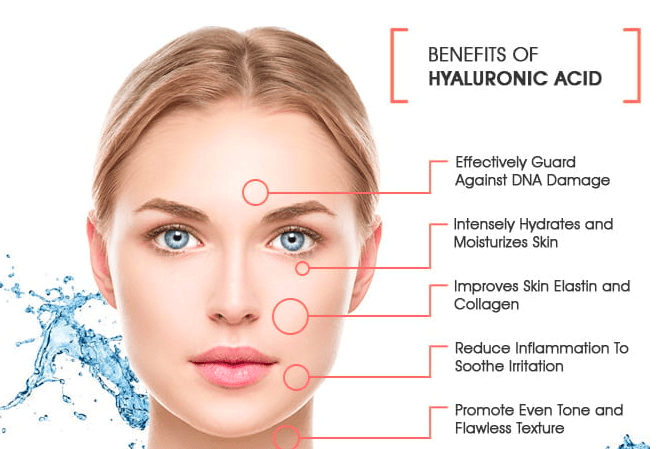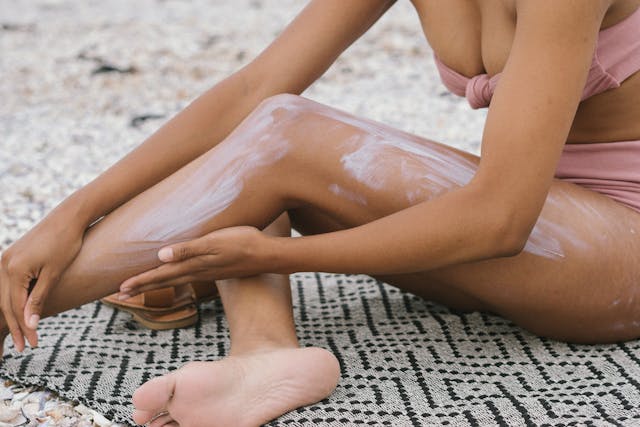
WHAT IS HYALURONIC ACID, FIRST OF ALL?
Our bodies contain the naturally occurring chemical hyaluronic acid, sometimes known as “HA,” in practically every fluid and tissue, primarily in the skin, eyes, and joints. In actuality, the skin contains about 50% of the total HA.

Our skin’s suppleness and hydration depend on hyaluronic acid. Unfortunately, HA’s concentration and molecular weight significantly decline with ageing. Hyaluronic acid has been extensively studied and developed as a potent active component in serums, moisturisers, and other cosmetic products as a result.
- HYDRATION
Hyaluronic acid equals hydration.
Hyaluronic acid can be compared to a BIG glass of water for your skin. It can contain 1,000 times more water than its own molecular weight. Hyaluronic acid penetrates the skin, binds water to skin cells, and provides the skin’s entire surface with beneficial, revitalising moisture.
With other products, pure hyaluronic acid serum can be layered. It also doesn’t require a tonne of additional ingredients or fillers to work.
2. HUMECTANT
In skincare, humectants are frequently utilised. A humectant is similar to a sponge in that it will continue to absorb and hold onto moisture even after it has been gathered. They draw water and permit hydrogen bonds. Ingredients like glycerin, sorbitol (sugar alcohol), hexylene and butylene glycol, and of course hyaluronic acid are examples of humectants used in skincare products.
Hyaluronic acid functions as a humectant and continues to take moisture from the environment after providing the epidermis (top layer of the skin) with essential moisture. The skin will receive constant hydration as a result.
3. INCREASED RESILIENCE
The lipid barrier is further strengthened and shielded by hyaluronic acid, which further improves the skin’s ability to protect itself from environmental contaminants and age-related factors. The skin is less wrinkly, brighter, and more bouncy for a longer period of time when it is not fighting these pollutants.
A helpful reminder is that preservatives, which are present in many products, can damage your barrier by eradicating the healthy microorganisms that protect your skin’s surface from toxins. Moisture is lost as a result, and discomfort or infection may even occur. Look for items with few preservatives and few substances. Many people who have oily or acne-prone skin prefer to use more abrasive chemicals to “strip” the skin of oil. It’s crucial to understand that most acne-prone skin lacks a robust lipid barrier, which promotes irritation and inflammation. Pure Hyaluronic Serum is suggested for people with sensitive or acne-prone skin since it promotes moisture and helps to safeguard the lipid barrier.
4. LIPID BARRIER ENHANCEMENT
The primary purpose of our skin is to protect our body. Naturally, our skin shields our internal organs, muscles, bones, and other body parts from the outside environment. But in addition, the skin shields the body from the damaging poisons that are constantly thrown at us.
The epidermis, the top layer of skin, is most heavily damaged by external factors (toxins). The lipid barrier, which is made up of fatty acids that keep water in and keep irritants out of the skin, weakens with age. Damage is caused by a variety of factors, including UV radiation, environmental pollution, and dietary habits like smoking. More fine lines and wrinkles, dark spots, and drier skin are all effects of this damage.
Hyaluronic Acid strengthens the skin’s natural defences to aid in securing moisture for a more potent moisturising impact. This can assist to preserve and strengthen the lipid barrier over time by slowing down its degradation.
5. A SLIMMER SKIN TONE
Nobody desires sagging skin. Ever. Elastin in the skin breaks down as we age, causing the skin to lose its snap and bounceback. Pinch the skin on the top of your hand to quickly test your elastin (the bounceback). You still have a lot of elastin if it snaps back rapidly. The skin won’t
recover as quickly as it once did as you age. Try the test on your mother or grandma the next time you see them, but don’t tell them why—really there’s no reason to, since it can’t be corrected.
Hyaluronic acid can aid with the appearance of tightness in the skin, but it won’t replace your elastin. Hyaluronic acid tightens the overall complexion by hydrating the skin. It contributes to a more youthful appearance by firming the facial features. Additionally, you can tell your mother and grandmother about that.
6. MODERATE TEXTURE
Hyaluronic acid smooths the skin’s texture in a manner similar to how it makes the skin appear tighter. This produces a finish that is both visible and tactilely velvety.
Hyaluronic acid won’t cover acne scars that are clearly visible on the skin. But over time, hyaluronic acid and a dermaroller can help skin look smoother when used together.
7. FINE LINES AND WRINKLES ARE LESS VISIBLE.
Never too early to begin nourishing and preserving the skin. Hyaluronic acid is a genuine substance that improves skin between the ages of twenty and eighty.
By keeping moisture in the skin and reducing the appearance of fine lines and wrinkles, hyaluronic acid gives the appearance of plumping the skin. Increased skin cell production can occur when the skin is well-protected and well-hydrated because it won’t have to work as hard to stay hydrated. Skin cells become smoother and plumper as a result.
One of the first places on the body where fine lines and wrinkles appear is the skin around the eyes. Two times a day application of an eye cream will assist maintain skin hydrated and supple and delay the appearance of new wrinkles.
8. REGENERATES SKIN CELLS AND STIMULATES
Hyaluronic acid helps enhance skin cell regeneration by providing the skin with additional hydration and barrier protection, even while it won’t hasten the process of cell renewal. This naturally results in healthier cells and a complexion that is more radiant.
9. PIGMENTATION
Like in point #8, hyaluronic acid aids in reducing and preventing age spots and pigmentation problems when there is an increase in cell turnover. But it can’t accomplish this on its own. Hyaluronic acid should be combined with a vitamin C serum or booster product when treating dark spots.








